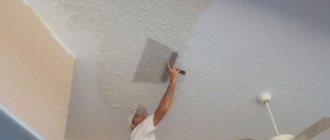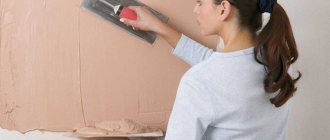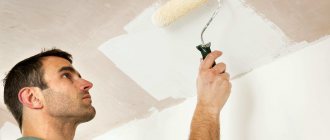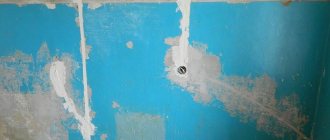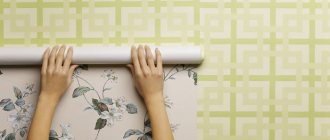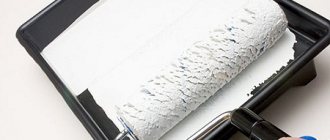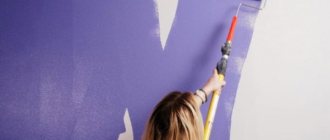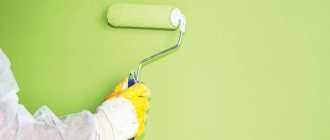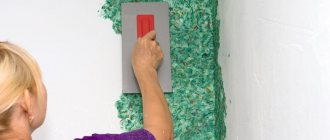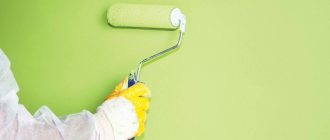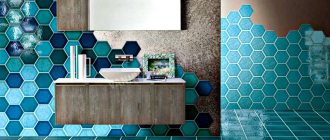Painting the ceiling with your own hands: advice from professionals
It is possible to paint the ceiling with enamel yourself. Before painting yourself, you need to study the sequential painting instructions, as well as professional advice for those who decide to do the finishing themselves.
Tips and Tricks:
- You need to paint quickly.
- When painting several levels, you need to use your own tools for each.
- Use a plastic barrier to protect the walls from splashes.
- Glue web and masking tape are useful for carefully painting surface joints.
- Allow the paint to dry evenly in a dark, draft-free room.
When painting the ceiling yourself, it is important to pay attention to the surface putty. Paint should be applied using the wet edge rule. Layers of paint must be applied strictly after the previous layer has completely dried.
For a high-quality result, you can paint the ceiling with “Snowball” - this is a paint that has won the trust of quality and reasonable price
Layers of paint must be applied strictly after the previous layer has completely dried. For a high-quality result, you can paint the ceiling with “Snowball” - this is a paint that has won the trust of quality and reasonable price
Paint should be applied using the wet edge rule. Layers of paint must be applied strictly after the previous layer has completely dried. For a high-quality result, you can paint the ceiling with “Snowball” - this is a paint that has won the trust of quality and reasonable price.
Do I need to prime a previously painted ceiling before painting?
Attention! If you are in doubt whether you need to prime the ceiling before painting the old paint, this is necessary if the previous layer consists of water-based paint, and the new color will be different from the old one. If it is nitro enamel, then it needs to be sanded and then primer applied - this way the new color will last longer.
Do I need to prime the ceiling before repainting?
Conclusion The arguments in favor of priming the ceiling before painting are convincing enough to make an unambiguous conclusion - a primer is needed. ... And the last requirement is that the ceiling is painted only after the primer solution has completely dried.
Is it possible to paint without primer?
When is it possible
- Wallpaper does not require preliminary priming before painting, since its structure implies adhesion to the dye without intermediaries.
- When the walls are treated with latex-based finishing putty, which does not crumble.
When not to
- A primer is necessary when gluing wallpaper for reliable adhesion to the walls.
- When using drywall in finishing. The sheets are coated twice: immediately after installation, and after the paint has dried for better fixation.
- When repainting an old layer of paint with a new color. In this case, the primer allows you to neutralize the show-through of the old finish.
Primer before coating with acrylic paint
When using acrylic paint, the wall or ceiling must be treated with acrylic primer. It is worth noting that it is necessary to treat surfaces that are not protected with a primer mixture. That is, those where paint will be applied. These reasons include:
- brick walls;
- plastered surfaces;
- drywall;
- concrete surfaces.
Acrylic primers are universal. They increase adhesion and level out the absorption capacity of the surface due to the formation of a thin film. Subsequently, this will have a positive effect on the amount of paint used and the quality of the finish.
Before priming, surfaces must be cleaned of the old coating, taking into account that acrylic primer is not applied to glossy, smooth or damaged substrates. Cracks, chips and holes must be removed using putty.
Hardeners for paints and varnishes - what are they?
Features and purpose
A paint curing agent is a chemical type compound that must be added to paint materials that will convert the paint into an infusible and insoluble product. Fusing into the structure of the material, it will be endowed with its stable properties. There are several types of such material, and their number will exceed the number of solvents. With the right choice of hardening additive, you can change the elasticity and strength of paints and varnishes and even slightly change colors.
The properties of the added component will directly depend on its chemical composition. In most cases, the substance will be used to add to resins, resulting in an epoxy adhesive composition. The peculiarity of the hardener lies in the conditions of its storage, and it is not recommended to pour the substance into another container, because within a short time the hardener for enamels and other products will lose its properties and may also become unusable. After adding to the paint, it should be used for several hours, and after that it can become unusable. Once the component is added to the paint, it should be applied within a few hours.
Advantages of using a hardener
Adding such a component will have many advantages, although it has certain features, although there are still more positive properties.
- Becomes resistant to sunlight (does not fade).
- Increases resistance to wear of the coating. For example, the service life of acrylic paint will increase to 20 years.
- The use of the component will provide a 100% guarantee that the coating will dry as quickly as possible.
- For some types of paints and varnishes, the hardener will give a glossy shine, as a result of which there is no need to additionally coat the surface with a varnish composition.
Such connections will have an increased degree of resistance to mechanical stress. The elasticity coefficient will increase, and the paint will not crack even in the corners and at the joints of parts. The service life of acrylic paint will be increased to 20 years.
Technology of painting the ceiling over old water-based paint
When repainting a ceiling with water-based paint, it is advisable to use the same color that the ceiling was painted in, otherwise there is a risk that the ceiling will have to be painted many times to achieve the desired result.
A thick paint straight from the can will lay out too prominently, no matter how good the paint roller is. The brush may leave grooves. A small 2-3cm brush can be used to cover corners or hard to reach areas.
Additional information: How to paint walls with water-based paint over old oil paint
Water emulsion is much more attractive from all points of view:
- non-toxic because it is diluted with water and not with chemicals;
- the walls - floor - ceiling breathe under it;
- stays on walls for up to 12 years without losing its qualities;
- practically no smell;
- dries quickly;
- Easy to apply and economical.
Is it possible to apply water-based paint to oil paint?
– the question is controversial. Different masters give completely contradictory advice on this topic. And they all seem quite logical.
Carefully inspect the oil finish that is to be repainted. Typically the coloring is from the late 80's or much earlier. In the 90s, water-based painting was already widely used.
Almost all surfaces were painted using water emulsion.
Considering the above advantages of water-dispersion paints over enamels, it is not surprising that they are crowding out solvent-based products in the market of paints and varnishes. The consumer’s desire to use more environmentally friendly, cheaper and durable materials is understandable. But, unfortunately, it will not be possible to simply apply water-dispersion paint to a surface previously painted with PF enamel. How to remove oil paint from a kitchen ceiling? The most radical method of solving the problem is to remove the old paint.
With the help of “Paint Destroyer B-52” you can easily get rid of any putties and alkyd enamels without damaging the surface being cleaned.
Ceiling treatment
Before painting the ceiling with water-based paint, you need to decide on the primer with which it will be treated. If there is a need to plaster the ceiling, then a deep penetration acrylic base is suitable.
For finishing ordinary and plasterboard ceilings, a universal type is used. To work, you need to stock up on a roller, tray and brush.
Initially, the corners are processed with a brush, and only then the entire ceiling is primed with a roller. After the applied layer has dried, you can immediately begin painting.
When priming the ceiling, you should remember that if the base is infected with fungus, it must be treated with antiseptic agents.
These are a kind of special preparations, after application of which the risk of fungus will be minimal.
Experts recommend applying the mixture in several layers before painting. A certain amount of time must pass between the stages of applying layers so that the primer can dry well.
Features of priming a painted wall
The main task of the soil solution is degreasing. Therefore, it is perfect as a base before painting the surface with enamel, solvent-soluble or water-dispersion paint, even over oil paint. Priming the prepared surface has its own characteristics that need to be remembered during work:
- The mixture must be homogeneous before application. This can be achieved by constantly stirring the mixture with a wooden stick.
- If the consistency is too thick and it is not possible to apply it in a thin layer, the primer should be diluted with water, but the water content should not exceed 10%.
- To make it easier to distribute the solution, you can use a paint roller and a tray as a tool. This will create the thinnest and most uniform layer possible.
- You need to start from the bottom, moving gradually upward, avoiding the appearance of drips. If during the process excessive accumulations of primer material are formed in one place, they should be smeared with a roller immediately, since after drying such a defect can spoil the final result.
- In places where the painting tool does not allow you to apply the solution evenly, you can use a brush of the required size - it will also do the job perfectly.
If the oil paint has an almost glossy surface, then after applying a thin layer and completely drying it, the primer solution is applied again. Usually it takes an hour, but provided that the temperature in the room does not exceed 20 degrees and the humidity is about 80%. This period is approximate, but it is necessary to observe it so that the composition provides excellent adhesion to the surface.
Types of binders according to drying type
Drying as a result of oxidation by atmospheric oxygen
The film is formed after the evaporation of water or an organic solvent, followed by the reaction of the film former with atmospheric oxygen.
Binders: epoxy ester, alkyd, alkyd-urethane.
Drying physically
The film is formed after the evaporation of an organic solvent or water.
Binders: chlorinated rubber, bitumen, acrylic resins, vinyl-chloride copolymers, acrylic, vinyl, polyurethane aqueous dispersions.
Cured by a chemical reaction
The film is formed after the evaporation of solvents followed by a reaction between the binder and the hardener or air moisture.
Binders: epoxy, epoxyacrylic, polyurethane, silicone, silicate, acrylic resins with hydroxyl groups.
How to properly prime walls with old paint
Primer solutions first perform the main task of degreasing. To get started, you must properly dilute the substance.
The mass should be homogeneous. This happens during the process of mixing the substance. If the composition is too thick, it must be diluted with water. Do not forget that the solution must stand for 2-3 hours. After this, the substance is mixed again until homogeneous.
To conveniently distribute the composition, use a roller. Start working from the bottom, gradually moving up. During the process, make sure that there is no dripping of the plaster.
The solution should sit for 2-3 hours.
Preparing the work surface
After a positive decision on the question of whether it is necessary to prime the ceiling before painting, a number of preparatory measures should be carried out that determine the service life of water-based paint.
Direct preparation is carried out in the following order:
First of all, you need to clean the surface of the old coating.
Whitewashing with chalk solution can be washed off with plain water, lime is also washed off with warm water, more complex compositions can be removed using special solvents. Particular attention should be paid to existing grease stains, traces of dirt and dust. High-quality cleaning of the surface and a positive solution to the problem of whether it is necessary to prime the ceiling before painting largely determines the degree of adhesion of the paint to the base.
Features of using primer GF 021
To improve the strength of paint and varnish coatings, the primer GF 021 is most often used. This is a glypthal-based primer composition, which is considered a universal product that is suitable for treating many surfaces.
What is primer GF 021
GF 021 is one of the products of the well-known manufacturer of dry construction mixtures BROZEX. Due to its excellent compatibility with many paint materials and the formation of a matte or semi-gloss layer with high adhesion rates, the primer has gained high popularity. Today it is used not only as an additional component, but also as an independent alkyd coating.
Purpose and scope of application
Primer GF 021 is designed to protect metal from corrosion. Mainly used in the construction and automotive industries, but can be used for priming wood-based materials such as chipboard, fibreboard or MDF.
When applied to the surface, this mixture forms a solid base for further processing (painting, varnishing). It is ideal for processing wood and metal materials that may be exposed to heavy moisture.
Specifications
GF 021 is manufactured according to GOST 25129-82 standards from the following components:
- 54-80% organic substances and suspensions;
- titanium dioxide as a solid filler;
- pentaphthalic varnish;
- catalysts to speed up drying of the mixture;
- stabilizers and solvents.
In cold or moderate climates, the coating can retain its protective properties for up to 4 years. As for presentability, the original appearance can last more than one year, depending on weather conditions and climate.
Consumption
For optimal effectiveness and preservation of properties, it is recommended to apply the finished solution at a temperature of 5-30°C. This is required by primer certification, which is issued on the basis of laboratory tests and a detailed analysis of the composition of the mixture. The consumption of the dry mixture is 60-100 g per 1 sq. m. m.
Advantages and disadvantages
Thanks to the constituent components and properties of GF 021, the primer composition has the following advantages:
- High wear resistance;
- Cost-effectiveness of materials used after applying the primer;
- Can be used at temperatures from -45 to +60 degrees;
- Resistance to environmental influences;
- High level of adhesion;
- Affordable price.
In addition to the advantages, primer GF 021 has its disadvantages - a long drying period, as well as a decrease in efficiency when applied to deteriorating materials. This is due to the weak permeability deep into the surface of the material.
Instructions and recommendations for use
The process of using a primer, regardless of the condition and type of material, is carried out in two stages. First, the surface must be prepared for application of the primer: cleaned and degreased. After this, you can begin processing.
Preparing the base
First of all, it is necessary to rid the working surface of old paint, rust, scale and unnecessary roughness.
This can be easily done with the help of modern tools: a drill, a grinder with special attachments in the form of metal brushes and brushes. After mechanical cleaning, care must be taken to remove greasy stains that may prevent the soil mixture from joining the surface. To do this, use degreasing organic substances or solvents: white spirit, acetone, kerosene, CarFit, W900, trichlorethylene and others.
When priming bases made of ferrous metals, rust converters are used, which are added to the composition of the primer mixture. One of these reagents is RE-4V. A quarter of the substance must be thoroughly mixed with the solution to achieve a uniform consistency.
Secrets and methods of application
Depending on the nature and volume of work, various methods of applying primer are used:
- manually using special tools;
- air;
- airless;
- electric;
- pneumatic.
The manual application method involves the use of paint brushes or brushes. They are suitable for processing small areas, but for larger jobs it is better to use wool or mohair rollers. As for ordinary foam rollers, it is better not to use them, since some solvents can corrode the material. When applying primer using sprayers, it is necessary to dilute the mixture in such a way that the result is a homogeneous, viscous consistency. For effective spraying, it is necessary to choose the right sprayer so that the holes are not very large or small. Also, when spraying the primer, it is necessary to use protective equipment to avoid getting the substance into the eyes and respiratory tract.
Questions and answers
Does concrete need to be primed before painting?
The porous structure of concrete and heterogeneity when absorbing moisture leads to uneven distribution of paint over the surface. In addition, the pores in the concrete will quickly absorb moisture from the paint, which, according to technology, should evaporate during drying. This will cause stains.
The primer will create a thin film and ensure uniform application of the coloring composition to the concrete surface.
It is mandatory to prime surfaces before applying water-based paint. This will increase the reliability of the coating and reduce repair costs in the form of paint savings. But most importantly, it will allow you to achieve the desired result when carrying out repair work. The primer not only protects the surface, but also allows you to reveal the properties of the finishing material one hundred percent.
How to thin paint for a spray gun: proper use of solvents
A spray gun is a special device used for quick, uniform and effective painting of various surfaces, products and parts. Every painting material has a certain composition and viscosity characteristics. Therefore, when starting to work with a tool, you need to not only familiarize yourself with its design, but also learn how to properly dilute the paint for the spray gun.
What types of surfaces can be treated
Before painting or not - it depends on the type of coating. Although, according to expert painters, the primer cannot harm any finishing layer. It contains components that ensure adhesion to the wall to be treated and protect it from the formation of fungi and corrosion. The primer also differs from paint in its minimal content of coloring pigment.
During the repair process, paint is applied to the following types of coatings:
- Plaster is usually lime, gypsum or cement mortar with sand. If the finishing layer is made with high quality, then it will look perfect after painting.
- Putty is a plastic mass used as a cosmetic finishing; it is used to mask defects in plastered surfaces.
- Drywall - this material is used to decorate different rooms. At the same time, in rooms with high humidity (kitchen, bathroom), the simplest and most reliable way of decorating is painting.
- – the process of applying a dye on top of the wallpaper allows you to hide the cracks that have formed in the rough plaster.
Now let’s talk about whether it is necessary to apply a primer to the listed surfaces. Despite the fact that water-dispersion paint fits perfectly onto a plaster or putty layer, they must still be treated with an adhesive compound. Several factors explain this need:
- 1. The primer contains polymers that help strengthen the finishing layer and prevent it from cracking and falling off.
- 2. Plaster, like putty, is too porous a material; they, like a sponge, are able to absorb a lot of liquid, which means that the consumption of paint when processing such an unprimed wall increases.
Some craftsmen, in order not to prime the putty before painting, go over it with a water-dispersed paint composition, after diluting it with more water. This approach is acceptable, but not economical, because primer is much cheaper than paint. Priming before painting plasterboard surfaces is also carried out in order to reduce paint consumption and increase the moisture resistance of the finished surface. It should be noted that plasterboard walls must be primed twice. The first time was immediately after installing the panels, the second time was after puttying work.
Now, regarding the need to apply a primer composition over old wallpaper in order to prepare it for painting with water-based paint. In this case, priming helps to impregnate not only the paper, but also the base to which it is glued. As a result, when the primer dries, a durable monolithic layer is formed, which after painting does not peel off even with fluctuations in humidity and changes in room temperatures.
Why is it so important to know how to properly dilute spray paint?
When the working composition for a spray gun is made incorrectly, difficulties arise during the work that prevent the mixture from being applied to the surface efficiently. As a result, many defects appear and the work has to be redone, which entails additional costs and loss of time.
There are many reasons to understand how to dilute paint for a spray gun:
- It is almost impossible to apply viscous and thick paint evenly over the entire surface, for example, a car, in the thinnest layer. In addition, in this case, the mass consumption increases, and an excessively thick layer applied to a car or any other element takes longer to dry.
- When surfaces that are inclined or in a vertical position are painted with a thick or liquid mass, for example, if it is a ceiling or wall, smudges form, which can only be eliminated by new painting.
- Not every device model can withstand the supply of liquid paint.
- An excessively viscous composition, for example, if you need to paint a home gate or an iron fence, will not be able to fill the unevenness of the canvas. As a result, the coating will be uneven, and corrosion will form on surface imperfections after a certain period of time.
- You will have to apply a too diluted and liquid mass in a large number of layers, and the work itself will take much more time.
Attention! Regardless of the price of the spray gun, it is necessary to choose a high-quality coloring mass for it.
Types of primers by composition: which one is suitable for paint
Naturally, the composition of the solution affects how long the primer takes to dry. Let's look at the popular types and their characteristics:
- alkyd (oil) is applied to wooden and metal surfaces, works well in working with rust (restores the damaged area, has a coloring effect), dries in 3-4 hours;
- perchlorovinyl composition is used for metal and other surfaces, but you can
only work with it outside, since it contains toxic components that emit an unpleasant odor, its main advantage is complete drying in 1 hour; - The polyvinyl acetate mixture dries in 40 minutes, but is only suitable for subsequent finishing with paints containing dispersion and latex.
An acrylic (universal) primer is considered universal. It has low surface tension, no specific odor, and maximum drying time is 5 hours. The only negative is that it does not combine well with metal surfaces (with rust).
Acrylic deep penetration primer for paint
Some manufacturers, for example, the domestic company LNPP, produce deep penetration acrylic primer. Its composition is absorbed by the surface to a depth of more than 1 cm and compacts it. Therefore, it is recommended to use an acrylic primer before painting materials with a loose porous surface.
Let us note, taking into account the instructions for using the deep penetration mixture from the LNPP company, that its final drying time is not 5 hours, as described above, but 24. This is explained by the characteristics of the treated surface for which this composition is intended.
https://youtube.com/watch?v=j6s3w2mef28
The following factors affect the drying time of the primer:
- type of surface: if it is porous and dry, the primer takes longer to dry than applied to a smooth surface;
- surface material: walls on which putty is applied dry faster than plastered ones;
- the thickness of the solution layer or the number of these layers;
- indicators of temperature and humidity of the room (4 hours for rooms with normal humidity indicators (up to 65%) and an average temperature of up to 25 ° C (for LNPP products, the formation temperature does not exceed 20 ° C), if the indicators deviate upward, the drying time increases to 8-12 hours).
How long does it take for primer to dry? Drying times for the primer are indicated on the packaging.
How to glue wallpaper on painted walls: water-based, oil and acrylic coating
If we are not talking about a new building, when carrying out repair work you have to decide what to do with the old covering on the walls. Ideally, it should be removed, but this is a labor-intensive process that lengthens the repair time. If paint has been applied to the walls, there is a desire to leave it. Let's find out in what cases it is possible to glue wallpaper on water-based paint and how to do it in order to achieve a high-quality and durable coating?
Will the wallpaper stick to the “water emulsion”?
It is permissible to glue new finishing material directly onto old paint, but only under certain conditions, the main one of which is the strength of the paint coating.
Let's consider cases when it is necessary to remove paint from walls:
- If it does not adhere well to the surface, it peels off in large fragments.
Sometimes it is difficult to visually determine how firmly the painted layer adheres. You can check it with tape: a piece of it is glued to the wall and then torn off. The absence of paint particles on the tape is an indicator of the strength of the coating.
- The surface of the paint was covered with a network of small cracks and chips.
- There are pockets of mold or mildew on the wall.
In all other cases, applying wallpaper to water-based or oil-based paint is possible with appropriate preliminary preparation.
Checking old coating
What can happen if you paste wallpaper directly onto a layer of paint? A happy outcome in this case is almost guaranteed to be excluded. The canvases may simply fall off due to low adhesion to the wall, peel off along with the paint, or become cracked. Therefore, checking and preparing the walls is mandatory.
First of all, the type of paint is determined. Not only the properties of the coating depend on it, but also the technology for its preparation before gluing the wallpaper to painted walls.
- Oil paint has a specific smell, forms a thicker layer and is much easier to peel off from the wall in separate fragments.
- The properties of enamel are similar to oil enamel, but it usually lasts much better.
- The layer of water-based emulsion, acrylic or latex, is thinner. Its adhesion strength to the wall is much higher.
Once you are sure that the old paint is indeed water-based, you should carefully examine its surface. At this stage, they look to see if there are any signs described above, and also check the strength of adhesion to the base of the wall using tape.
Technology for gluing wallpaper onto water-based paint
Before wallpapering, you don’t have to remove the paint layer if 2 conditions are met:
- with firm confidence in its strength and quality;
- with strict adherence to technology during preparatory work.
Disadvantages of walls painted with dispersion dyes may become apparent during the preparation process. Thus, when applying a primer, which is a mandatory step, peeling of the surface or the appearance of blisters may occur. In this case, removal of the old finish is necessary.
Materials and tools
Materials you may need:
- Putty for eliminating minor defects on walls.
- Primer. Its use is mandatory. It is better to give preference to deep penetration compositions based on acrylic. If the colored wall has a dark shade, then using a pigmented white primer it can be “painted” so that the old coating does not show through under the light-colored canvases.
- Non-woven wallpaper. They are preferable for use in this case: they are lighter than vinyl and stronger than paper.
- Adhesive composition. Better from a well-known manufacturer. This is the case when a low price most likely indicates low quality. There is no need to skimp on wallpaper glue.
Even a novice master will have tools for the job:
- Brush or vacuum cleaner.
- Spatula and grater. Will be required if you have to eliminate minor wall defects.
- Roller and brush. Needed when priming, as well as in the process of attaching wallpaper.
- Level, sharp scissors, painting knife, pencil.
- Rubber roller. It is convenient for them to smooth out the panels, preventing the formation of bubbles.
Preparing the walls
- If necessary, uneven areas and cracks are cleaned and smoothed with putty.
- The entire surface is rubbed using fine sandpaper or an abrasive mesh. This will increase the adhesion of the smooth coating.
- The walls are freed from dust. You can use a brush, but a vacuum cleaner is better.
- A deep penetration primer is applied. This operation must be repeated at least twice, and in perpendicular directions. The second time is primed only after the first layer has completely dried.
After such processing, pasting is carried out in a standard way, guided by the rules for the selected type of wallpaper.
Gluing process
Instructions for gluing wallpaper:
- Using a measuring tool, lines are laid on the wall that will help to correctly place individual fragments. This is much more reliable than gluing by eye.
- Pieces of wallpaper are cut to the required size. For insurance, it is better to leave a small margin of 2–3 cm.
If there is a pattern, careful cutting of the roll is required. It is often more profitable to cut off the necessary fragment from a new tube than to cut out and throw away significant pieces from the old one.
- Wallpaper glue is prepared according to the seller's recommendations indicated on the package.
- The glue is evenly applied to the fragment using a roller or brush. When gluing non-woven wallpaper, which is most preferable for this case, the wall is also covered with the adhesive, avoiding drops or smudges. The process of gluing vinyl on paper is described here.
- The piece is carefully applied to the marks on the base and smoothed with a rubber roller, a special spatula or a cloth in the direction from the center to the edges. This removes folds and expels air from under the surface of the wallpaper.
When creating a coating that has a general pattern and consists of individual stripes, an important point is the high-quality installation of the first fragment. Its oblique location will entail distortion of the rest, which is difficult or almost impossible to correct.
- Similarly, adjusting the pattern, the following strips are glued. To make the joints stand out less, it is better to start the process from the window.
- After the wallpaper has dried, remove excess with a painting knife. It will be easier to do this on a plinth or baguette.
A high-quality result is impossible without creating an appropriate microclimate in the room: drafts are eliminated for the entire duration of the process and the temperature is ensured around +18 °C. At higher temperatures, the wallpaper may sag; at lower temperatures, it will not dry well.
It will be easier to identify surface flaws during the pasting process if you provide lighting in the room from several sources so that the rays fall on the wall at an acute angle.
What to do if the paint does not pass the test?
In this case, you must carefully remove the coating from the water-based emulsion, being careful not to damage the base of the wall. The easiest way to do this is with a spatula, moistening the surface with hot water. This is the safest and most environmentally friendly way.
Subsequently, the wall is leveled, primed and wallpaper is glued in the usual manner.
General information
Of course, if the old paint is cracking and peeling, then finishing over it is out of the question. But, often you have to deal with a coating that adheres so well that it cannot be scraped off with a regular spatula. In this case, it simply does not make sense to remove the old finish.
However, paint is a smooth, low-porous surface, so adhesion between the new coating and the base may be poor, which will lead to the fragility of the finish. To eliminate this drawback, special primer compositions should be used.
Neomid soil
For example, if you need a primer for oil-based paint, you can use Neomid or a coating from a domestic manufacturer - VD-AK-0301. True, the latter is intended only for use under water-based paint, while Neomid can be used before puttying, plastering and other types of finishing.
To make sure that priming is necessary, you just need to understand the difference between primer and paint.
There are actually a lot of differences:
- The primer contains less pigments.
- Contains special additives that give the material various properties, including: Improve adhesion between materials;
- Accelerate drying;
- The composition is endowed with antiseptic properties, etc.
It follows that the coloring composition cannot replace the primer. True, in some cases it is permissible to use water-based paint instead of primer, diluted in a 50:50 ratio.
For example, sometimes paint is used - a primer for concrete, plaster and putty. However, the price of this material is much higher than that of soil, so this solution is not economically justified.
Primer VD-AK-0301
In addition, there is a special primer - metal paint, which can be used as a primer that protects the surface from corrosion, or as an independent paint. An example of this is Zinga conductive paint.
Paint-primer Zinga
What the pros advise
As a rule, the proportional ratio of paint and solvent is one to one (how much paint, so much thinner needs to be poured).
True, the result of coloring directly depends on the application technology.
“The first paint ball should be applied using the “dry” method. To do this, you need to add one dose of diluent to two doses of the coloring agent. Thus, the structure is reliably protected from distortion, it will be smoother, and the paint will lie evenly.”
After fifteen to twenty minutes, you can paint into the next ball. To do this, prepare the composition to dilute in the classic proportional ratio, and go over the entire base well with a spray bottle.
Preparation for painting
Traditional option
What operations should precede painting a base covered with old paint?
- Cleaning the paintwork.
- Puttying to eliminate minor defects.
- Grinding a surface to make it rough.
- Application of primer selected for the type of surface and composition of the new paint.
However, in some cases, removing old paint is problematic.
The list of possible reasons is quite extensive:
- Limited resistance of the base to washes.
- Insignificant heat resistance, which does not allow using a hair dryer to soften the old coating.
- Low mechanical strength of the base, which does not allow old paint to be removed with a spatula or sanding.
- Finally, just a larger surface area to paint. Imagine that you have to paint a hundred or two square meters of surface alone. Here you can’t help but think: is it worth spending several days, or even weeks of work on cleaning it?
Priming on paint
Fortunately, thanks to modern primer compositions, you can make your life much easier.
Primer over old paint is quite possible if several conditions are met:
- The coating is not glossy. If so, you will still have to spend time rough sanding it.
- Old paint does not peel off. Where its layer comes off, it must be cleaned.
Primers for old paints are versatile: they become an intermediate layer between the old and new coatings, having equally high adhesion to both of them.
Required tools and materials
Before work on renovating the ceiling, you need to prepare all the tools necessary for the work. It is better to always have them at hand than to run around looking for them in the midst of repair work.
To prepare the surface for painting you may need:
- metal spatula for removing old putty and applying new putty;
- spray or sponge material to remove old paint;
- serpyanka reinforcing mesh for sealing large cracks;
- starting and finishing putty;
- simple or deep penetration primer;
- grout mesh.
To paint a ceiling well, you need to have:
- for economical paint consumption, a cuvette;
- for painting corners and junctions of walls and ceilings, use a wide and narrow brush;
- for painting large areas, a fluffy roller with a long handle.
To protect furniture from dust and splashes, use polyethylene film.
Can oil paint be coated with water-based emulsion?
Water-based emulsion is a high-quality, harmless dye that allows you to paint walls/ceilings in any shade. It is also worth noting that with this type of paint coating you can also hide cracks whose depth is no more than 1 mm. This composition is easily diluted with water, and the materials used for painting are easily washed. However, you should not be afraid that the painted wall or ceiling will be washed off when wiping the dust with a damp cloth. But doubts arise as to whether the water-based emulsion will work on oil-based paint. This is due to the fact that when the paint composition dries, it partially loses moisture. On the oil layer of the previous coating, the outer layer does not allow absorption, which leads to runoff or peeling. The walls of commercial and residential premises can be repainted with such compositions, since they are environmentally friendly and also wash well. If the surface was previously painted with oil paint, which adheres well, then you can apply a new layer over it, taking into account the recommendations below. If the previous finishing material adheres firmly enough to the surface, it can be left. But at the same time it is necessary to comply with certain preparation conditions. Otherwise, after a few weeks the new coating will begin to wear off/crumble. It is also worth noting that this type of painting should only be done if the surface is not subject to intensive use. Although it is technically acceptable to apply water-based emulsion to oil-based paint, finishers tend to strip everything completely. This will allow you to avoid possible difficulties or incidents in the future, as well as perform high-quality coloring in the specified colors. The only drawback of using this approach is to indicate only the larger time and economic costs, so when doing repairs yourself, this method is rarely used. In order for the water-based emulsion to adhere well to the surface to be painted, it must be soaked. But the old oil coating almost does not allow moisture to pass through. Accordingly, the application will be uneven. In worn or scratched areas it will be absorbed more, and where it is not possible to completely clean everything, the new layer may completely slide off.
Removing the old layer
Concrete primer for water-based paint
Concrete, despite its apparent density, is a porous material. To eliminate increased paint consumption and make the surface bright and rich after painting, you need to close the pores in the concrete.
To prime concrete walls and ceilings, it is necessary to use impregnating, deep-penetrating and adhesive compounds.
Also, when choosing a primer, you need to take into account the base of the water-based paint. The coloring material can be made on the basis of acrylic, latex, PVA glue
A combination of primer and paint material is considered ideal.
The following primers will help prepare concrete surfaces for further painting:
- acrylic – penetrating and adhesive;
- polyurethane – adhesive, removes dust, fills pores, protects against chemical influences;
- alkyd – deeply penetrating, abrasion resistant;
- polyvinyl acetate - used as a primer for paint and PVA glue.
What is quartz soil used for?
Primer
“
Quartz
-
Ground
” (Acrylic) (TM “Bayris”) is intended for preliminary priming and strengthening of prepared substrates before applying acrylic decorative plasters, “PROFI” series paints and mineral plasters. Used for interior and exterior work.
Interesting materials:
How does the post office work in April 2022? How does the post office work in January 2022? How do banks work for the New Year 2022? How do banks work in Ukraine on New Year's Day? How did they celebrate the New Year in Rus' before? How is sick leave calculated in 2022? How to recognize otitis in a child under one year old? How to calculate a child's 15th birthday? How to calculate family income for the year? How to calculate apartment tax in 2019?

